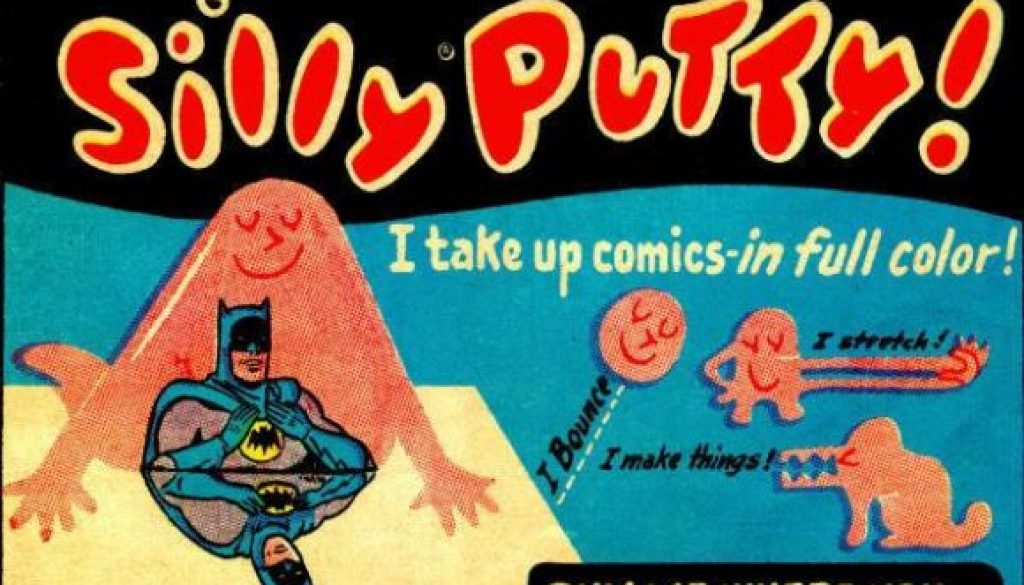Silly Putty Powered Ideas
A recent conversation with a friend of mine lead to him describing the creative process he was going through as “molding a new idea out of clay.” That statement sparked an image in my mind, but (as with most ideas) I kept building on it in my own brain and came to the realization that “molding ideas” was a great metaphor for creativity but clay was too limiting… we needed a material that was even more malleable and mutable than clay.
We needed Silly Putty.
If you think about it, Silly Putty is the physical embodiment of all the best characteristics of brainstorming and idea generation.
 Silly Putty Stretches
Silly Putty Stretches
New ideas should stretch our personal sensibilities and the world’s possibilities. How many products and services to we enjoy today that were once proclaimed to me impossible by past standards? Safe electrical power in our homes, flight, space travel, home computers, recorded/broadcast audio and video, and many more. When you think you’ve reached the perfect solution, tug on the edges just a little bit more and see how far you can stretch it.
Silly Putty Bounces
It’s a cliched phrase: “let’s bounce around a few ideas” but how many of you have actually thought about that process? Ideas get bigger, bolder, and better when the end result is influenced by a variety of people with a variety of opinions and life experiences. The way approach the solution to a problem is very different than the way you would by the simple virtue of our personal backgrounds. Yours isn’t any more or less valid than mine, it’s just different. Bouncing around an idea means releasing it from your grip and letting someone else control the bounce, spin, and speed of the idea. But the process isn’t complete until everyone involved gets to express their own bounce and then return the idea to you for your own final spin.
Silly Putty is Malleable
Silly Putty is best described as a dilatant fluid, where viscosity increases with the rate of shear strain (I’m no chemist, visit Wikipedia for full details.) Basically it’s the reason you can compress Silly Putty into a rather solid cube, but enables it to stretch, break when sharply struck, and even flow like a liquid. Ideas are the same. They need to be shaped to fit the needs of the situation. It’s one of the reasons so many “new” ideas are actually new combinations of one or more “old” ideas. The hardest idea under the correct circumstances should be able to flow like water when the situation requires.
Silly Putty Lifts
As a kid I loved pressing Silly Putty into the Sunday funnies and getting a full-color image impression on the peach-colored goo. On the surface one might call it a copy, but look again. The initial image or text is mirrored, so even attempting to use Silly Putty to copy an idea results in being forced to view the copied idea in a new way. Taking that new image and twisting it, flattening it, wrapping it, twisting it, or limitless other options creates something new out of something old. You don’t need Silly Putty to use this same technique with your own ideas. Reverse them, flip them, stretch them out to make them larger or compress them into a tight little ball for a more concentrated concept.
Silly Putty is Sticky
The putty is actually a decent temporary adhesive. Pieces can be torn off, wadded into a ball, and used to affix posters to a wall (remember Fun Tak?) keep a pen from rolling off a desk, attach a note to a computer, etc. Keep in mind 3M didn’t start test marketing a Post-It Note style product until 1977 — Silly Putty has been around as a toy since 1949! This is also how great ideas are recognized. The best ones stick with you. It doesn’t matter if you discuss 50 ideas afterward, that one idea will stick with you through the process. It’s the one you keep revisiting, knowing that there is “something there.” It’s a sign that the idea also has the potential to stick in the mind of others.
Silly Putty was an Accident
Like all the best ideas, Silly Putty was discovered by accident. During WWII all rubber products were being rationed. In an attempt to solve this shortage, the U.S. government began funding research into synthetic rubber compounds. From the Silly Putty entry on Wikipedia:
(Researchers) discovered that reacting boric acid with silicone oil would produce a gooey, bouncy material with several unique properties. The non-toxic putty would bounce when dropped, could stretch farther than regular rubber, would not go moldy, and had a very high melting temperature.Wright found that the substance did not have all the properties needed to replace rubber, so it was not used for any purpose. In 1945 Wright sent samples to scientists all around the world, but no practical use was ever found.
The aforementioned Post-It Notes are another example of an accidental invention; as were Velcro, Teflon, Microwave Ovens, Matches, Dynamite, Stainless Steel, Penicillin (and dozens of other innovations.) When trying to uncover new ideas, don’t be afraid to stray from the path into unexplored territory. You don’t discover buried treasure by digging in the same place as everyone else. You also need to keep your radar up (which, by the way, was also discovered by accident!) in order to recognize the opportunities that these accidents lay at your feet.
Although it may be difficult to predict just when and where you’ll need to come up with the next big idea, it’s easy to prepare yourself for success — just keep one of those small plastic eggs within reach.




